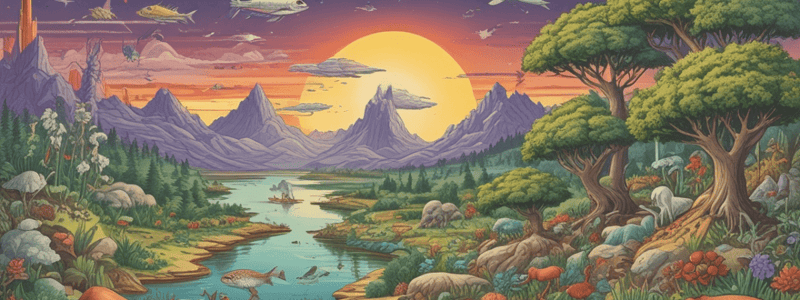Podcast
Questions and Answers
What is the primary source of energy and building materials for plants?
What is the primary source of energy and building materials for plants?
- Light and water (correct)
- Predators and prey
- Parasites and hosts
- Other animals and plants
What type of relationships exist between organisms in a food web?
What type of relationships exist between organisms in a food web?
- Only producer/consumer relationships
- Producer/consumer, predator/prey, and parasite/host relationships (correct)
- Only predator/prey relationships
- Only parasite/host relationships
What is the effect of a decrease in one population on other populations in a food web?
What is the effect of a decrease in one population on other populations in a food web?
- Only indirect effects on other populations
- No effect on other populations
- Both direct and indirect effects on other populations (correct)
- Only direct effects on other populations
What is a characteristic of all organisms in a food web?
What is a characteristic of all organisms in a food web?
What is a food web?
What is a food web?
What is the role of a producer in a food web?
What is the role of a producer in a food web?
What is an example of a direct interaction in a food web?
What is an example of a direct interaction in a food web?
What would happen to the population of Freshwater Clams if the population of Chubb increased?
What would happen to the population of Freshwater Clams if the population of Chubb increased?
What would happen to the Leeches population if Mallard Ducks were removed from a food web?
What would happen to the Leeches population if Mallard Ducks were removed from a food web?
What is the function of the seven gill slits in a sea lamprey?
What is the function of the seven gill slits in a sea lamprey?
What is the relationship between a flea and Alfred?
What is the relationship between a flea and Alfred?
What is the main characteristic of a producer in a food web?
What is the main characteristic of a producer in a food web?
What happens to the native species when an invasive species is introduced to an environment?
What happens to the native species when an invasive species is introduced to an environment?
What is a characteristic of an invasive species?
What is a characteristic of an invasive species?
What is an example of a predator/prey relationship?
What is an example of a predator/prey relationship?
What would happen to the Foxes and Raccoons population if Mallard Ducks were removed from a food web?
What would happen to the Foxes and Raccoons population if Mallard Ducks were removed from a food web?
Flashcards are hidden until you start studying
Study Notes
Energy and Building Materials
- Animals obtain energy and building materials by consuming other animals and plants.
- Plants produce their energy and building materials using light and water.
Food Webs and Chains
- A food web is a network of interconnected food chains.
- A food chain is a diagram showing feeding relationships among organisms (producer/consumer and predator/prey).
- In a food chain/web, a change in one population affects others through direct and indirect interactions.
Identifying Components
- Producers: organisms that make their own food (e.g., plants, algae, aquatic plants).
- Consumers: organisms that consume their food by eating plants and/or other animals (e.g., yellow perch, mice).
- Predators: organisms that hunt and eat other organisms (e.g., walleye, great blue heron).
- Prey: organisms that are eaten by predators.
Interactions and Effects
- Direct interactions: relationships between organisms that directly affect each other.
- Indirect interactions: relationships between organisms that affect each other indirectly.
- Removing an organism from a food web can have a ripple effect on the entire ecosystem.
Structure and Function
- Organisms have specific structures that allow them to carry out different functions (e.g., breathing, eating, moving, reproducing).
- Examples: sea lamprey's gill slits for breathing, a bird's wings for flying.
Relationships Between Populations
- Types of relationships: producer/consumer, predator/prey, and parasite/host.
- Producers: plants that produce their own food.
- Consumers: animals that consume plants and/or other animals.
Invasive and Native Species
- Invasive species: organisms that enter an environment where they do not normally live, negatively impacting native species.
- Native species: organisms normally found in a particular environment.
- Examples: sea lamprey in the Great Lakes (invasive), grass (native).
Studying That Suits You
Use AI to generate personalized quizzes and flashcards to suit your learning preferences.




